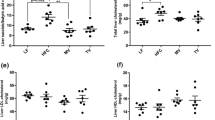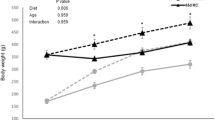Abstract
Malnutrition contributes to the development of oxidative damage in the central nervous system. The selective administration of nutrients tends to show positive results in individuals who have suffered from malnutrition. To determine the effect of the administration of cocoa powder on the peroxidation of lipids and glutathione level during the nutritional recovery in brain, rats of 21 days old were subjected to a protocol that resembles malnutrition (MN) by feeding them with 60% of the daily food consumption of the control group (WN) and later to nutritional recovery with regular rodent feed (RFR) or added with cocoa (10 g of cocoa powder/kg of regular rodent feed) (CCR). Animals fed with regular rodent food showed significant reduction in brain glutathione: RFR (84.18 ± 6.38 ng/mg protein) vs. CCR (210.61 ± 50.10 ng/mg protein) and WN (186.55 ± 33.18 ng/mg protein), but with similar level to that of MN (92.12 ± 15.60 ng/mg protein). On the contrary, lipid peroxidation in RFR-fed animals increased RFR (1.32 ± 0.2 μM malondialdehyde/g of tissue), CCR (0.86 ± 0.07 μM malondialdehyde/g of tissue), WN (0.89 ± 0.09 μM malondialdehyde/g of tissue), but their thiobarbituric acid reactive substances concentration is similar to that of MN group (1.50 ± 0.2 μM malondialdehyde/g of tissue). Consumption of cocoa powder as a source of antioxidants favors the restoration of the concentration of glutathione and reduces the damage caused by oxidative stress during nutritional recovery in rat brain.





Similar content being viewed by others
References
Adkins SM (2009) Recognizing and preventing refeeding syndrome. Dimens Crit Care Nurs 28:53–58
Baba S, Osakabe N, Natsume M, Yasuda A, Takizawa T, Nakamura T (2000) Cocoa powder enhances the level of antioxidative activity in rat plasma. Br J Nutr 84:673–680
Becker K, Pons-Kühnemann J, Fechner A (2005) Effects of antioxidants on glutathione levels and clinical recovery from the malnutrition syndrome kwashiorkor a pilot study. Redox Rep 10:215–226
Cai Q, Rahn RO, Zhang R (1997) Dietary flavonoids, quercetin, luteolin and genistein, reduce oxidative DNA damage and lipid peroxidation and quench free radicals. Cancer Lett 119:99–107
Dobbing J (1990) Vulnerable periods in the developing brain. In: Dobbing J (ed) Brain, behavior and iron in the infant diet. Springer, London, pp 1–25
Fechner A, Böhme C, Gromer S, Funk M, Schirmer R, Becker K (2001) Antioxidant status and nitric oxide in the malnutrition syndrome kwashiorkor. Pediatr Res 49:237–243
Feoli AM, Siqueira I, Almeida LM (2006) Brain glutathione content and glutamate uptake are reduced in rats exposed to pre and postnatal protein malnutrition. J Nutr 136:2357–2361
Georgieff MK (2007) Nutrition and the developing brain: nutrient priorities and measurement. Am J Clin Nutr 85(suppl):614S–620S
Gutteridge MC, Halliwell B (1990) The measurement and mechanism of lipid peroxidation in biological systems. Trends Biochem Sci 15:129–135
He XJ, Yi ZW, Tian Y, Lu XY, Dang XQ, Mo SH, Yang HB (2006) Ability of catechin to eliminate O2–* and *OH. J Cent S Univ Med Sci 31:138–140
Hertog MG, Kromhout D, Aravanis C, Blackburn H, Buzina R, Fidanza F (1995) Flavonoid intake and long-term risk of coronary heart disease and cancer in the seven countries study. Arch Intern Med 155:381–386
Hissin PJ, Hilf R (1976) A fluorometric method for determination of oxidized and reduced glutathione in tissues. Anal Biochem 74:214–226
Lee IM, Paffenbarger RS (1998) Life is sweet: candy consumption and longevity. BMJ 317:1683–1684
Lee KW, Kim YJ, Lee HJ, Lee CY (2003) Cocoa has more phenolic phytochemicals and a higher antioxidant capacity than teas and red wine. J Agric Food Chem 51:7292–7295
Li J, Wang H, Stoner GD, Bray TM (2002) Dietary supplementation with cysteine prodrugs selectively restores tissue glutathione levels and redox status in protein-malnourished mice. J Nutr Biochem 13:625–633
Manary MJ, Leeuwenburgh C, Heinecke JW (2000) Increased oxidative stress in kwashiorkor. J Pediatr 137:421–424
Manjarrez GG, Magdaleno VM, Chagoya G, Hernández J (1996) Nutritional recovery does not reverse the activation of brain serotonin synthesis in the ontogenetically malnourished rat. Int J Dev Neurosc 14:641–648
Martín MA, Serrano AB, Ramos S, Pulido MI, Bravo L, Goya L (2008) Cocoa flavonoids up-regulate antioxidant enzyme activity via the ERK1/2 pathway to protect against oxidative stress-induced apoptosis in HepG2 cells. J Nutr Biochem. doi:10.1016/j.jnutbio.2008.10.009
Masella R, Di Benedetto R, Varì R, Filesi C, Giovannini C (2005) Novel mechanisms of natural antioxidant compounds in biological systems: involvement of glutathione and glutathione-related enzymes. J Nutr Biochem 16:577–586
Miller KB, Hurst WJ, Payne MJ, Stuart DA, Apgar J, Sweigart DS, Ou B (2008) Impact of alkalization on the antioxidant and flavanol content of commercial cocoa powders. J Agric Food Chem 56:8527–8533
Natsume M, Osakabe N, Yamagishi M, Takizawa T, Nakamura T, Miyatake H, Hatano T, Yoshida T (2000) Analysis of polyphenols in cocoa liquor, cocoa, and chocolate by normal-phase and reversed-phase HPLC. Biosci Biotechnol Biochem 64:2581–2587
Okushio K, Suzuki M, Matsumoto N, Nanjo F, Hara Y (1999) Identification of (−)-epicatechin metabolites and their metabolic fate in the rat. Drug Metab Dispos 27:309–316
Osakabe N, Yamagishi M, Sanbongi C, Natsume M, Takizawa T, Osawa T (1998) The antioxidative substances in cocoa liquor. J Nutr Sci Vitaminol (Tokyo) 44:313–321
Osakabe N, Yasuda A, Natsume M, Takizawa T, Terao J, Kondo K (2002) Catechins and their oligomers linked by C4→C8 bonds are major cocoa polyphenols and protect low-density lipoprotein from oxidation in vitro. Exp Biol Med 227:51–56
Piskula MK, Terao J (1998) Accumulation of (−)-epicatechin metabolites in rat plasma after oral administration and distribution of conjugation enzymes in rat tissues. J Nutr 128:1172–1178
Scalbert A, Johnson IT, Saltmarsh M (2005) Polyphenols: antioxidants and beyond. Am J Clin Nutr 81(1 Suppl):215S–217S
Sidhu P, Garg ML, Dhawan DK (2005) Protective effects of zinc on oxidative stress enzymes in liver of protein-deficient rats. Drug Chem Toxicol 28:211–230
Sies H, Stahl W, Sevanian A (2005) Nutritional, dietary and postprandial oxidative stress. J Nutr 135:969–972
Ventrucci G, Ramos SLG, Roston MMA (2004) Effects of a leucine-rich diet on body composition during nutritional recovery in rats. Nutrition 20:213–217
Weisburger JH (2001) Chemopreventive effects of cocoa polyphenols on chronic diseases. Exp Biol Med 226:891–897
Acknowledgments
The authors want to express their gratitude to Dr. Cyril Ndidi Nwoye, a native English speaker, for translating this manuscript.
Conflicts of interest
We declared that there are no conflicts of interest.
Author information
Authors and Affiliations
Corresponding author
Rights and permissions
About this article
Cite this article
Barragán Mejía, G., Calderón Guzmán, D., Juárez Olguín, H. et al. The administration of food supplemented with cocoa powder during nutritional recovery reduces damage caused by oxidative stress in rat brain. Naunyn-Schmiedeberg's Arch Pharmacol 384, 499–504 (2011). https://doi.org/10.1007/s00210-011-0676-0
Received:
Accepted:
Published:
Issue Date:
DOI: https://doi.org/10.1007/s00210-011-0676-0




